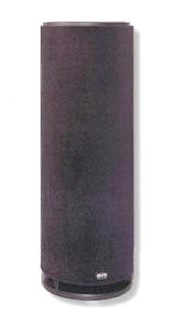Product Review - SVS CS-Ultra
Subwoofers - May, 2002
John E. Johnson, Jr.
![]()
|
|
Specifications: Driver: 12" Kevlar & Aluminum Cone Power Handling: 500 Watts Each Nominal Impedance: 4 Ohms MFR: 16 Hz - 100 Hz ± 3 dB Size: 39" H x 16" Diameter Weight: 72 Pounds Enclosure: Cylindrical Polymer Laminate; Birch End-Caps; Black Knit Sock Covering MSRP: $959 Each; $1,399 for One Subwoofer and 1,000 Watt Stereo Power Amplifier; $1,999 for Two Subwoofers and 1,000 Watt Stereo Power Amplifier (500 Watts per Channel) |
|
SVS Subwoofers, http://www.svsubwoofers.com |
Introduction
As a deep bass aficionado, I am always in the mood to try new designs. SVS is
a relative newcomer to the subwoofer market, and their products are only sold
on the Internet. In fact, you can't even call them by phone. "That would add
to the cost", they say in their brochure, and cost is a factor that we are all
interested in. SVS is selling subwoofers like hotcakes, and for good reason,
as you are about to see.
The Design
SVS subwoofers are cylindrical in shape. This is for two reasons. One is that a cylinder is less expensive to build, because the inside does not need bracing, while box enclosures do need bracing. Secondly, and more importantly, a cylinder has less standing waves than a box because the sides are not parallel. This sounds like two real good advantages, so why doesn't everyone build their subwoofers as cylinders? There are several reasons for this too. One is that the cylinder look is not very spouse acceptable. I could not find a single female who liked the look of these subwoofers (Stacey Spears says he knows a few who do). For bachelors though, they are not a problem at all, obviously. Tom Vodhanel, of SVS, is a bachelor living on 16 acres. Stacey Spears has SVS subs in his home theater, and you guessed it, he is single. So is John Kotches, another SVS owner. Secondly, subwoofers come these days with a built-in power amplifier. Where do you mount a power amplifier on a cylinder? The bottom has the driver, and the top has the ports. SVS does make a smaller line of subs with the amp built-in, but for the CS-Ultra, a big amp is required. SVS supplies power amplifiers separately, from companies like Samson and Crown. You have to put that power amp somewhere else, near the sub, and that means additional space being used. Even the EQ (crossover) is a separate item, with your choice of Rane PE-17 or Art-351. Ours came with the Rane Parametric EQ. More about that later.
The SVS cylinder is a polymer laminate, meaning epoxy and cardboard. It does not need to be made out of MDF because a cylinder is strong by nature. This makes the sub somewhat lighter in weight which is nice when you have to move it around. In other words, MDF is not necessary, which would otherwise increase the cost significantly.
The driver, custom manufactured for SVS, is 12" in diameter, with a huge rubber surround and very heavy magnet structure (shown below). The cone is aluminum. This driver is the major part of the cost of the SVS, in the range of several hundred dollars. After all, you can buy a 12" driver for $30. That is not the case here. The SVS is a heavily engineered driver.
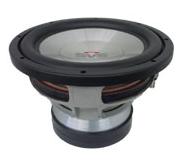
The top of the cylinder has the flared ports, and there are three of them, each 3" in diameter. This is much more port area than on a typical subwoofer, and the reason is that the driver has a 2" excursion capability. Indeed, when I tested the SVS with sine waves at, say 25 Hz, a hurricane was coming out of those ports.
The top is covered with a black metal perforated grille, underneath of which are several small foam strips to keep the grille from vibrating during use.
The speaker binding posts are at the bottom, just to the side of the driver. They point downward, which makes it a little difficult to access them. I use banana plugs on the test cable (Nordost Red Dawn), so I had to utilize the bare wire holes in the posts rather than inserting the bananas into the back ends.
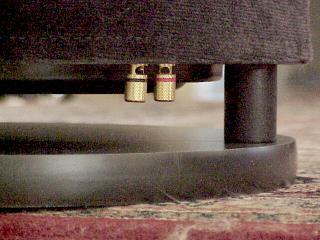
A Samson S1000 power amplifier (545 watts x 2 into 4 Ohms) came with the SVS (included as part of the purchase price), along with a Rane PE-17 Parametric Equalizer ($399 option). The Samson is a touring amplifier, which is designed to drive 4 Ohm loads without difficulty. You can connect a single input signal, switch the amp to parallel operation (the input goes to both channels), and you connect one channel output to one sub and the other channel output to the second sub. In my tests, I found a single subwoofer to put out tremendous SPL at low frequencies, so if you don't plan to run stereo subs, a single SVS is fine. However, do not bridge the amplifier to drive the single sub in this case. Bridging reduces the ability of an amplifier to drive low impedances, and when I ran my Carvin power amplifier (also a touring amp) in bridged mode with the SVS at high volume, I burned it up. So, if you have the stereo amp and one sub, just drive it with one of the amplifier channels. Later on, if and when you decide to have stereo subs, connect one sub to each of the channel outputs, and run it in stereo mode rather than parallel. The inputs could come from either right and left sub-out on some receivers, or right and left rec-out, or right and left pre-out (Y connected to the right and left power amplifiers that drive the front right and left main speakers).
The Rane PE-17 is a five-band EQ with adjustable Q, meaning that you can choose how much bandwidth is to be included in each band of boost or reduction at a particular frequency. It is powered by a wall-wart, and will give you 12 dB of boost or 15 dB of reduction at any of the five frequency bands. Each band unit is identical to the other four, so starting on the left, you could set the first band unit to boost, say 25 Hz, by 3 dB, then, on the next band unit to the right, reduce 40 Hz by 5 dB, and so on, until you have used all five band units. Each band unit can be inserted or eliminated from the circuit by use of a bypass push-button. Adjusting the Q from 0.03 to 2 (the number represents octaves) will widen the amount of frequencies on either side of the chosen frequency, so that it could be a notch filter (reduction at 40 Hz with no reduction at 35 Hz or 45 Hz) by setting the Q to 0.03, or some significant reduction at 35 Hz and 45 Hz by setting the Q to a higher number, such as 0.5. There is a slider switch on each band unit allowing you to multiply the frequency setting on the dial by a factor of 10, 1, or 0.1. So, this gives you a lot of flexibility in a frequency range of 10 Hz to 20 kHz. On the far left side of the panel are sliders to let you select a low-cut of 10 Hz to 250 Hz (so, if 250 Hz were selected, nothing below 250 Hz would pass through), and high-cut of 3 kHz to 40 kHz (so, if 20 kHz were selected, nothing above 20 kHz would pass through). There are also sliders to raise or lower the overall input and output by 12 dB. XLR and 1/4" Phone Plug inputs and outputs are supplied. I used the XLR balanced, as this makes a big difference in keeping hum out of the subwoofer circuit.
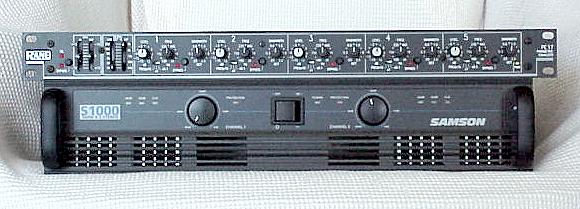
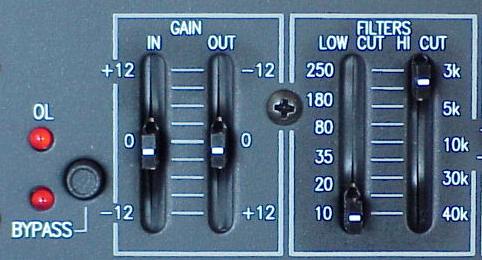 |
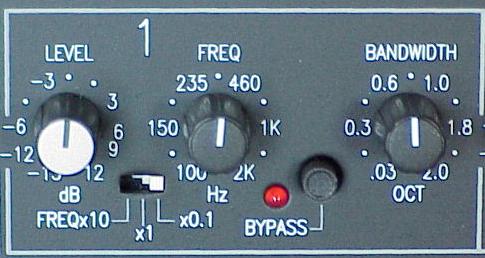 |
Because the SVS has such big ports, it is important to keep frequencies less than 15 Hz out. Otherwise, the sub can start flopping around at high SPL. You can use the Rane's low-cut slider for this. If you don't want to get the EQ unit, SVS offers another unit that will let you filter out the really low frequencies (called a "Rumble Filter" in the old days).
Although you could use the Rane as a crossover by setting the high-cut to 3 kHz and a couple of the band units set to about 1 kHz, maximum reduction, and a Q of 2, all receivers come with a sub-out these days, having a crossover of 80 Hz to 120 Hz, so this is not necessary. In fact, receivers and processors are now starting to have crossovers with various choices down to 40 Hz or so. Therefore, you could choose, say, 50 Hz in the processor, and use the band units for EQ (increasing or lowering output at several different frequencies).
Click HERE to go to Part 2 - The Sound and the Bench Tests
![]()
© Copyright 2002 Secrets of Home Theater & High Fidelity
Return to Table of Contents for this Issue.

